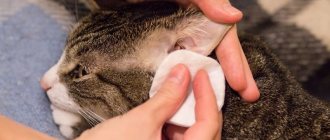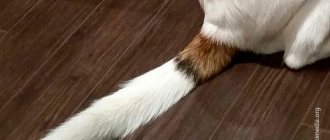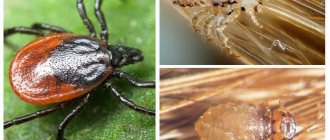Itchy ears in dogs is an extremely unpleasant thing. Owners often call it “ear mange.” The ears may itch deep inside, and no matter what the dog does, the unpleasant sensation does not go away. The dog can scratch its ears with its front and hind paws, rub its head on the carpet, furniture, and people. If you see that your pet is often and intensively trying to “help” you scratch, jerking its back paw when you pat it behind the ear, as if it were scratching itself, welcome to see a veterinarian. If the itching is severe, the dog may scratch his ears until they bleed. It is better not to let this happen and take action at the first signs of illness. It is always easier to prevent a disease than to treat it, and an examination by a doctor is never superfluous.
Diagnostics
Only a veterinarian can make a diagnosis based on anamnesis (collection of information about the pet’s lifestyle), examination and additional research. For example, otoscopy of the middle and inner ear will make it clear where the inflammatory process is localized, and microscopy of the discharge from the auricle will show what exactly could cause the inflammation.
What symptoms may bother your dog besides itching:
- pain - the dog will whine and actively rub its ear with its paws, tilting its head. Trying to look may cause anxiety, discomfort or aggression on the part of the animal;
- a “squelching” sound when pressing on the base of the ear or when the dog shakes its head;
- local redness of the skin, swelling;
- discharge from the ear that is black, gray, yellow or off-white;
- foul odor from the ears;
- enlarged submandibular lymph nodes, general depressed condition of the dog, lethargy;
Each of these symptoms indicates that something is wrong with your ears. The solution to the problem must be approached comprehensively and as quickly as possible.
Itchy ear - what could it be?
Otohematoma
Otohematoma is an accumulation of blood between the ear cartilage and the skin. It rarely causes itching, but it causes obvious discomfort to the four-legged friend - the dog whines and shakes its head. You will not confuse this disease with anything - the dog’s ear looks like an inflated hot balloon. The cause is damage to a blood or lymphatic vessel (capillary) due to injury. Dogs with floppy ears are predisposed to the appearance of otohematoma, but straight-eared breeds can also suffer. Often, an ear hematoma can occur due to itching, when the dog often scratches its ears, hitting the ear with its paw.
Treatment of otohematoma is usually surgical - drainage is installed at the site of the hematoma, and the skin is sutured to the cartilage.
Symptoms to watch out for
The first sign of otitis is the dog's obsessive scratching of the sore ear and constant shaking of the ears. In especially severe cases, the ears are torn to the point of bleeding, and dried wounds with traces of scratches are often observed. After seeing this phenomenon, it is important to examine your dog's ear. Looking inside, you will see a characteristic picture there - there is severe inflammation, a local increase in temperature, and there are various discharges. The color and smell of the discharge depend on the type of otitis media. With tick-borne otitis there is a black discharge, with bacterial otitis it is white-yellow, etc. A characteristic feature is the presence of severe itching, which really bothers the dog. With infectious otitis media, a squelching sensation is felt in the ears when palpated.
Inflammatory otitis media
Otitis media is an acute or chronic inflammatory process in the ear canal. Otitis media can be caused by the development of bacteria, fungi, or both. It may be a skin reaction to injury, parasites, or an allergen. Most often accompanied by severe swelling, inflammation, pain, itching and discharge from the ear with an unpleasant odor. Dog breeds with floppy ears are more prone to developing otitis media.
The treatment is comprehensive, using special medications in the form of drops and solutions, antiseptics and anti-inflammatory drugs. Particular attention is paid to finding the main cause that caused such inflammation.
When to contact a veterinarian
Scratching is not always a sign of illness. Normally, all dogs scratch their heads and try to get rid of wax on their own. Symptoms when you should contact a veterinary clinic:
- behavioral changes, restlessness and irritability;
- whining while scratching, when touching the ears;
- tilts and shakes his head to the side;
- the presence of a large amount of exudate, dirt in the ears;
- unpleasant odor;
- refusal to eat, poor sleep.
You should not delay visiting a doctor, as diseases can lead to complications and hearing loss.
Self-medication is dangerous, as qualified diagnostics are required to determine the cause of the problem.
Allergic otitis media
Ears are one of the most delicate and vulnerable places. If a dog has inflammation and otitis media of the external auditory canal, then in approximately 70% of cases it will be associated with allergies. The ears become inflamed with food allergies and with atopic dermatitis (allergies to environmental allergens) and allergies to parasites. The outer ear will appear inflamed, and when the owner tries to look inside, the dog may whine, snarl, and try to hide or run away. When examined by a veterinarian through an otoscope, inflammation with discharge (inflammatory secretion) will be detected.
As a rule, treatment for allergic otitis is complex and will be prescribed by a doctor individually for each dog. The treatment regimen may greatly depend on the cause of the allergy. In addition to complex treatment aimed at eliminating the cause of the allergy and relieving symptoms, sanitation and treatment of the ear canal with antibacterial and antifungal drugs will also most likely be prescribed. In order to reduce itching during treatment and thereby make the dog’s life easier, the doctor may prescribe Apoquel. This drug will relieve attacks of itching and eliminate the factor of trauma when scratching; it also helps relieve inflammation.
Briefly about the main thing
- Due to their anatomy, the ears are susceptible to diseases. Common problems include otitis media, tick infestation, allergies, and foreign body ingestion.
- Ear diseases are accompanied by itching and tilting of the head to the side. There may be a decrease in appetite and problems with sleep.
- Treatment can only be prescribed by a doctor. To make you feel better, you need to massage your ears and clean the shells of secretions.
- Proper ear care is an important part of preventing diseases and infections. It is required to carry out systematic cleaning, hair removal and treatment for parasites. Visit your veterinarian twice a year for a checkup.
Have you ever experienced ear problems in your dog? Share in the comments how to relieve your pet’s anxiety and discomfort before visiting the clinic.
Foreign body
A dog is not a child and cannot put a foreign object in its ear. But it is not uncommon for grass or tenacious plant seeds, burdock or an insect to accidentally get into the ear. The foreign body causes discomfort to the dog - the dog persistently rubs its ear with its paws and whines. It is necessary to examine the ear yourself as quickly as possible or take your pet to a veterinarian. If a foreign body remains in the ear for a long time, serious inflammation may develop, which will require long-term treatment.
Otodectosis
This is a parasitic disease caused by ticks of the genus Otodectes cynotis. The mite feeds on earwax, lymph and epidermis. The vital activity of the parasite causes unbearable itching and inflammation in dogs. Only a veterinarian can confirm the diagnosis of otodectosis after examination and laboratory diagnosis of the discharge - the mite can be easily seen through a microscope.
Dogs suffer from otodectosis much less frequently than cats. But a dog can easily pick up this parasite on the street or from a sick feline.
Treatment for otodectosis is quite simple - hygienic cleaning of the ears and a drug aimed at destroying the Otodectes cynotis mite. Simparica tablets are excellent for treatment and prevention. They do not have a toxic effect on the dog’s body, but are highly active against mites that cause otodecosis.
In addition to tablets, ear mites respond well to treatment with Stronghold drops. For complete recovery, one or two treatments with an interval of 30 days are enough. In the future, the drug can also be used for prevention.
Hematoma
photo from the site 4lapi.info
If the animal is mobile and active, then mechanical damage to the ears and, as a consequence, the formation of hematomas are not uncommon. For some, especially pugnacious breeds, doctors advise docking, but in most cases single injuries are treated in the same way: If there is severe bleeding, apply a pressure bandage (preferably in a clinic setting) and leave it for four to five days. After this, if necessary, the doctor will open hematoma, will remove dead tissue. If the wound is serious, it is recommended to apply stitches and secure the ear with a bow to the head until complete recovery. In two weeks it will completely heal. Depending on the type of stitches, they will either dissolve on their own, or you will need to come again and remove them.
Other parasites
In addition to ear mites, other parasites also attack dog ears - fleas, subcutaneous mites (demodex), scabies mites (sarcoptic mange), and ixodid (forest) mites. Bloodsuckers can be located anywhere on a dog’s body; they also love the ears, because the skin on them is tender enough to easily bite through it. The bites also cause itching. And when a dog itches, it can injure its ear. Trauma can cause both local inflammation and otohematoma. In addition to causing discomfort, fleas and ticks are carriers of dangerous diseases. Therefore, it is much easier to prevent all parasitic diseases than to treat their consequences.
The optimal solution for prevention is Simparica tablets. They protect against fleas and several types of ticks at once - ixodid (forest), ear (otodectosis), scabies (sarcoptic mange), subcutaneous (demodectic mange). In the warm season, the tablet is a dog’s salvation from many parasites and the diseases they carry.
Veterinarian advice
Ear diseases are extremely dangerous for dogs, as they can lead to hearing loss, one of the key sense organs of these animals. To avoid such problems, veterinarians advise undergoing preventive examinations at least 2 times a year, as well as timely treatment for parasites.
It is highly not recommended to self-medicate, since all otitis media have similar symptoms.
If you notice that your pet is scratching its ears or scratching its skin until it bleeds, seek help as soon as possible.
Diagnosis is important if the puppy scratches its ears and whines - at this age the risk of complications is higher.
Treatment
Treatment of the ears should be aimed at the cause of inflammation and itching. It is important to maintain hygiene and not allow your dog to itch. To prevent scratching, you can use a collar, but the best solution is Apoquel. This is an innovative drug for relieving itching during diagnosis and treatment. It solves the problem at the cellular level and is well tolerated by the four-legged friend.
For each case there is an individual treatment that must be prescribed by a veterinarian. In order for the doctor to see the clinical picture as much as possible, do not treat the dog’s ears with anything before the doctor’s appointment.
Prevention
The best way to combat a disease is its prevention. To prevent your dog from getting otitis due to parasitic diseases, treat your pet regularly for fleas and ticks. Drugs such as Simparica and Stronghold are active against these parasites and will protect your pets from uninvited guests.
Keep an eye on your pet's ears by cleaning them regularly with lotion and a cotton pad. Do not clean your ear with cotton swabs - this can cause harm. To clean your dog's ears, pour a small amount of lotion into the ear canal, massage the base of the ear and allow the dog to shake its head vigorously. Excess wax will end up on the inside of the ear, where it can be easily wiped off with a cotton pad or gauze.
If you know that your dog is prone to food allergies, carefully follow the diet and talk with all family members so that they do not feed it from the table. This is extremely important for allergic animals. For other types of allergies, when the first signs of exacerbation appear, contact your veterinarian as soon as possible to prevent scratching.
Health to you and your pets!
How to help at home
If you notice that your pet is constantly itching and appears restless, then he needs help. Procedures that you can carry out yourself:
- give ¼ tablet of an antihistamine - it will relieve itching and make you feel better;
- wipe your ears with a cotton pad soaked in water or chamomile decoction;
- inspect the inner surface for the presence of foreign objects, if possible, remove them;
- get rid of excess hair that can cause irritation;
- if the diagnosis is already known, then follow all the doctor’s recommendations - instillation, treatment with ointments;
- start massaging the ears to avoid mechanical damage to this place with claws.
If the dog appears restless, it needs to be calmed. When your pet is actively scratching itself, you can wrap the front and back paws with a bandage to avoid injury and infection.











